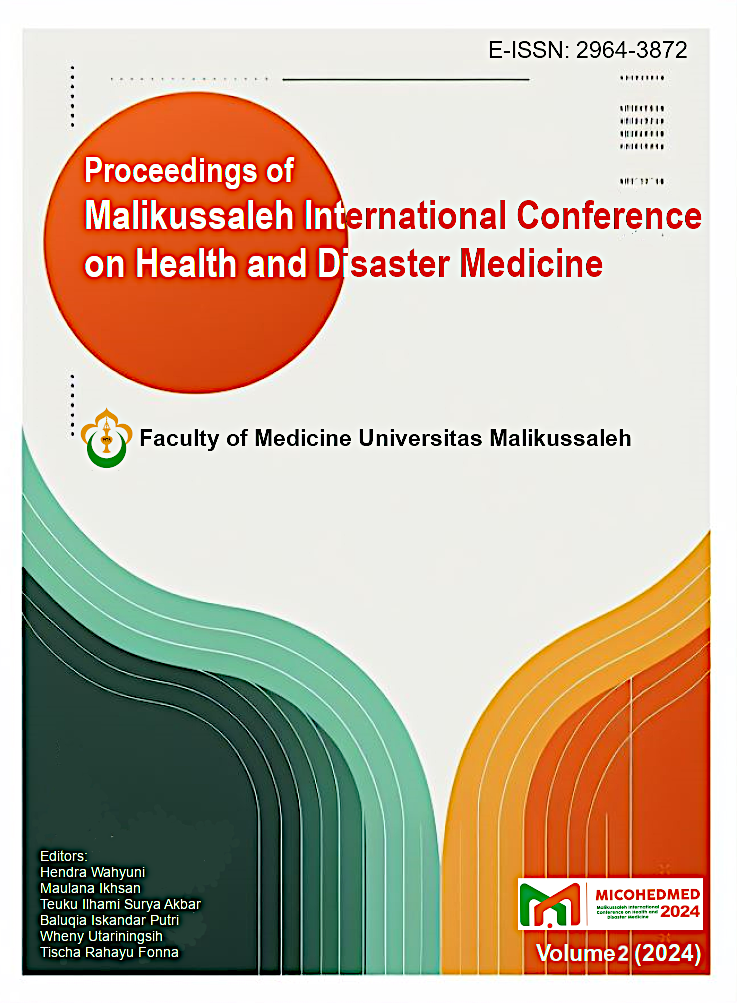Staphylococcus aureus Resistance to Several Antibiotics Isolated from Broiler Chicken Meat at the Traditional Market in Banda Aceh-Indonesia
DOI:
https://doi.org/10.29103/micohedmed.v2i.1204Keywords:
Antibiotics, broiler chicken, market, Staphylococcus aureus, resistanceAbstract
Staphylococcus aureus is a prevalent pathogen that frequently infects broiler chickens, with treatment typically involving the use of antibiotics. Antibiotic resistance refers to the ability of bacteria to withstand the effects of these drugs. This study aims to assess the prevalence of antibiotic-resistant S. aureus in broiler chicken meat sold at Traditional Market in Banda Aceh City. Employing a cross-sectional study, samples were collected through purposive sampling. A total of 100 breast meat samples from broiler chickens sourced from traditional markets in Banda Aceh City were analyzed. The antibiotics tested in this study included ampicillin, streptomycin, ciprofloxacin, and erythromycin. All positive isolates of S. aureus underwent MRSA testing. Data were analyzed descriptively. The findings reveal that out of the 100 samples, 10 tested positives for Staphylococcus aureus. Of these, four samples exhibited resistance to erythromycin (40%), two samples were resistant to ampicillin (20%), and one sample showed resistance to streptomycin (10%), while all ten samples were sensitive to ciprofloxacin (100%). Out of the 10 MRSA isolates analyzed, the mecA gene was detected in one isolate. Consequently, it can be concluded that broiler chicken meat sold in traditional markets in Banda Aceh City demonstrates varying levels of resistance to several antibiotics.
References
1. Abdalrahman, L. S., A. Stanley, H. Wells, and M. K. Fakhr. 2015.Isolation, virulence, and antimicrobial resistance of methicillinresistant Staphylococcus aureus (MRSA) and methicillin sensitive Staphylococcus aureus (MSSA) strains from Oklahoma retail poultry meats. Int. J. Environ. Res. Health. 2015;12:6148–6161.
2. Algammal AM, Hetta HF, Elkelish A, Alkhalifah DHH, Hozzein WN, Batiha GE, El Nahhas N, Mabrok MA. Methicillin-resistant Staphylococcus aureus (MRSA): one health perspective approach to the bacterium epidemiology, virulence factors, antibiotic-resistance, and zoonotic impact. Infect Drug Resist. 2020;13:3255-65. http://dx.doi. org/10.2147/IDR.S272733. PMid:33061472.
3. Avberšek J, Papić B, Kušar D, Erjavec V, Seme K, Golob M, Zdovc I. Feline otitis externa caused by methicillin- resistant Staphylococcus aureus with mixed hemolytic phenotype and overview of possible genetic backgrounds. Antibiotics. 2021;10(5):599. http://dx.doi.org/10.3390/ antibiotics10050599. PMid:34070191.
4. Amri, I. A., & Wulandari. Identification of Colibacillosis and Antibiotic Resistance Testing in Native Chickens. Vet Bio Clin J, 2022;4(1), 22-29.
5. Artati, H., & Armah, Z. Resistance Patterns of Staphylococcus spp. to Five Antibiotics in Pus Samples. Media Kesehatan Politeknik Kesehatan Makassar, 2016;11(2), 60-64.
6. Becker K, B. Ballhausen, B.C. Kahl, R. Kock The clinical impact of livestock-associated methicillin-resistant Staphylococcus aureus of the clonal complex 398 for humans Vet. Microbiol., (2017), pp. 33-38
7. [CLSI] Clinical and Laboratory Standards Institute. (2012). Performance Standards for Antimicrobial Susceptibility Testing; Twenty-Second Informational Supplement. Clinical and Laboratory Standards Institute, West Valley.
8. Cuny C, L.H. Wieler, W. Witte Livestock-associated MRSA: the impact on humans Antibiotics (Basel), 4 (2015), pp. 521-543
9. Darniati, Kadir M. D. A., and Rezfha, D. Detection of multidrug-resistance Klebsiella pneumoniae isolated from oropharyngeal swab in broiler chickens. IOP Conference Series: Earth and Environmental Science. 2024.
10. Dey TK, Shome BR, Bandyopadhyay S, Goyal NK, Lundkvist Å, Deka RP, Shome R, Venugopal N, Grace D, Sharma G, Rahman H, Lindahl JF. Molecular characterization of methicillin-resistant Staphylococci from the dairy value chain in two Indian states. Pathogens. 2023;12(2):344. http:// dx.doi.org/10.3390/pathogens12020344. PMid:36839616.
11. Elnageh HR, Hiblu MA, Abbassi MS, Abouzeed YM, Ahmed MO. Prevalence and antimicrobial resistance of Staphylococcus species isolated from cats and dogs. Open Vet J. 2021;10(4):452-6. http://dx.doi.org/10.4314/ovj. v10i4.13. PMid:33614441.
12. Evarozani, S., Kustyawati, M. E., Sartika, D., Subeki, & Utomo, T. P. Antibiotic Resistance of Escherichia coli Isolates from Broiler Sekum and Organic Broilers. Jurnal Ilmiah Peternakan Terpadu, 2023;11(1), 41-50.
13. Farrell, D (2013) The role of poultry in human nutrition. In: Poultry development review. FAO, Rome, ISBN 978-92-5-108067-2
14. Fergestad ME, Stamsås GA, Morales Angeles D, Salehian Z, Wasteson Y, Kjos M. Penicillin-binding protein PBP2a provides variable levels of protection toward different β-lactams in Staphylococcus aureus RN4220. MicrobiologyOpen. 2020;9(8):e1057. http://dx.doi.org/10.1002/mbo3.1057. PMid:32419377.
15. Fisher JF, Mobashery S. β-lactam resistance mechanisms: gram-positive bacteria and Mycobacterium tuberculosis. Cold Spring Harb Perspect Med. 2016;6(5):a025221. http:// dx.doi.org/10.1101/cshperspect.a025221. PMid:27091943.
16. Fitranda M, Salasia SIO, Sianipar O, Dewananda DA, Arjana AZ, Aziz F, Wasissa M, Lestari FB, Santosa CM. Methicillin-resistant Staphylococcus aureus isolates derived from humans and animals in Yogyakarta, Indonesia. Vet World. 2023;16(1):239-45. http://dx.doi.org/10.14202/ vetworld.2023.239-245. PMid:36855365.
17. Gajdács M. The continuing threat of methicillin-resistant Staphylococcus aureus. Antibiotics. 2019;8(2):52. http:// dx.doi.org/10.3390/antibiotics8020052. PMid:31052511.
18. Green BN, Johnson CD, Egan JT, Rosenthal M, Griffith EA, Evans MW. Methicillin-resistant Staphylococcus aureus: an overview for manual therapists. J Chiropr Med. 2012;11(1):64-76. http://dx.doi.org/10.1016/j.jcm.2011.12.001. PMid:22942844.
19. Hayati, L. N., Tyasningsih, W., Praja, R. N., Chusniati, S., Yunita, M. N., & Wibawati, P. A. Isolation and Identification of Staphylococcus aureus in Subclinical Mastitis of Ettawa Crossbreed Goat Milk in Kalipuro, Banyuwangi. Jurnal Medik Veteriner, 2019;2(2), 76-82.
20. Hyeon, J. Y., G. T. Chung, S. H. Bing, K. S. Kwon, H. H. Lee, S. J. Kim, S. E. Jeon, Y. H. Kang, and J. Kim. A foodborne outbreak of Staphylococcus aureus associated with fried chicken in Republic of Korea. J. Microbiol. Biotechnol. 2013;23:85–87.
21. Januari, C., Sudarwanto, M. B., & Purnawarman, T. Antibiotic Resistance in Escherichia coli Isolated from Chicken Meat in Traditional Markets in Bogor City. Jurnal Veteriner, 2019;20(1), 125-131.
22. Hanson, B. M., A. E. Dressler, A. L. Harper, R. P. Scheibel, S. E. Wardyn, L. K. Roberts, J. S. Kroeger, and T. C. Smith. Prevalence of Staphylococcus aureus and methicillin-resistant Staphylococcus aureus (MRSA) on retail meat in Iowa. J. Infect. Public Health. 2011;4:169–174.
23. Hiramatsu K, Ito T, Tsubakishita S, Sasaki T, Takeuchi F, Morimoto Y, Katayama Y, Matsuo M, Kuwahara-Arai K, Hishinuma T, Baba T. Genomic basis for methicillin resistance in Staphylococcus aureus. Infect Chemother. 2013;45(2):117-36. http://dx.doi.org/10.3947/ic.2013.45.2.117. PMid:24265961.
24. Kakoullis L, Papachristodoulou E, Chra P, Panos G. Mechanisms of antibiotic resistance in important gram-positive and gram-negative pathogens and novel antibiotic solutions. Antibiotics. 2021;10(4):415. http://dx.doi.org/10.3390/ antibiotics10040415. PMid:33920199.
25. Khairullah AR, Raharjo D, Rahmahani J, Suwarno, Tyasningsih W, Harijani N. Suwarno, Tyasningsih W, Harijani N. Antibiotics resistant at Staphylococcus aureus and Streptococcus sp isolated from bovine mastitis in Karangploso, East Java, Indonesia. Indian J Forensic Med Toxicol. 2019;13(4):439-44. http://dx.doi.org/10.5958/0973- 9130.2019.00329.3.
26. Krupa, P., J. Bystro´n, J. Bania, M. Podkowik, J. Empel, and A. Mroczkowska. Genotypes and oxacillin resistance of Staphylococcus aureus from chicken and chicken meat in Poland. Poult. Sci. 2014;93:3179–3186.
27. Magvirah, T., Marwati, & Ardhani, F. Antibacterial Activity of Staphylococcus aureus Using Tahongai Leaf Extract (Kleinhovia hospita L.). Jurnal Peternakan Lingkungan Tropis, 2019;2(2), 41-50.
28. Owuna, G., R. H. Abimiku, I. H. Nkene, G. W. Joseph, and O. O. Ijalana. Isolation and antibiotic susceptibility of from fresh poultry meat sold in Keffi Metropolis, Nigeria. Int. J. Res. Studies. 2015;3:1–5.
29. Paerunan, A., Sakung, J., & Hamidah. Analysis of Bacterial Content in Beef and Chicken Sold at Pasar Sentral Daya, Makassar City. Jurnal Kolaboratif Sains, 2018;1(1), 1-11.
30. Putra, A. R. S. P., Effendi, M. H., Koesdarto, S., Suwarno, Tyaningsih, W., & Estoepangestie, A. T. S. Identification of Extended Spectrum β-Lactamase Producing Escherichia coli Bacteria from Dairy Cattle Rectal Swabs Using Vitek-2 Method in Kud Tani Wilis Sendang, Tulungagung Regency. Jurnal of Basic Medicine Veterinary, 2019;8(2), 108-114.
31. Ramandinianto SC, Khairullah AR, Effendi MH. MecA methicillin resistant Staphylococcus aureus (MRSA) isolated from dairy farms in East Java, Indonesia. Biodiversitas. 2020;21(8):3562-8. http://dx.doi.org/10.13057/ biodiv/d210819.
32. Rastina, Abrar, N., Erina, Winaruddin, & Suryani. Resistance of Staphylococcus aureus Isolated from Chicken Meats to Some Antibiotics. International Journal of Tropical Veterinary and Biomedical Research, 2020;5(1), 1-5.
33. Raji, M. A., G. Garaween, R. Ehricht, S. Monecke, A. M. Shibl, and A. Senok. Genetic characterization of Staphylococcus aureus isolated from retail meat in Riyadh, Saudi Arabia. Front. Microbiol. 2016;7:911.
34. Wardhana, D. K., Haskito, A. E. P., Purnama, M. T. E., Safitri, D. A., & Annisa, S. Detection of Microbial Contamination in Chicken Meat from Local Markets in Surabaya, East Java, Indonesia. Veterinary World, 2021;14(12), 3138-3143.
35. Wulandari, A., & Rahmawardani, C. Y. Antibiotic Use Behavior in the Community. Jurnal Ilmu Kefarmasian, 2022;15(1), 9-16.
Downloads
Published
How to Cite
Issue
Section
License
Copyright (c) 2024 Rastina, M Daud AK, Denny I Hasan, Rosmaidar, Indah Mulya, Meli Br Sembiring Meliala, Bilqis Rizki Ilahi

This work is licensed under a Creative Commons Attribution-ShareAlike 4.0 International License.
n order for Proceedings of Malikussaleh International Conference on Health and Disaster Medicine (MICOHEDMED) to publish and disseminate research articles, we need non-exclusive publishing rights (transfered from author(s) to publisher). This is determined by a publishing agreement between the Author(s) and Proceedings of Malikussaleh International Conference on Health and Disaster Medicine (MICOHEDMED). This agreement deals with the transfer or license of the copyright of publishing to Proceedings of Malikussaleh International Conference on Health and Disaster Medicine (MICOHEDMED), while Authors still retain significant rights to use and share their own published articles. Proceedings of Malikussaleh International Conference on Health and Disaster Medicine (MICOHEDMED) supports the need for authors to share, disseminate and maximize the impact of their research and these rights, in any databases.
As a proceeding Author, you have rights for a large range of uses of your article, including use by your employing institute or company. These Author rights can be exercised without the need to obtain specific permission. Authors publishing in Proceedings of Malikussaleh International Conference on Health and Disaster Medicine (MICOHEDMED) proceedings have wide rights to use their works for teaching and scholarly purposes without needing to seek permission, including:
- use for classroom teaching by Author or Author's institution and presentation at a meeting or conference and distributing copies to attendees;
- use for internal training by author's company;
- distribution to colleagues for their reseearch use;
- use in a subsequent compilation of the author's works;
- inclusion in a thesis or dissertation;
- reuse of portions or extracts from the article in other works (with full acknowledgement of final article);
- preparation of derivative works (other than commercial purposes) (with full acknowledgement of final article);
- voluntary posting on open web sites operated by author or author’s institution for scholarly purposes,
(but it should follow the open access license of Creative Common CC-by-SA License).
Authors/Readers/Third Parties can read, print and download, redistribute or republish the article (e.g. display in a repository), translate the article, download for text and data mining purposes, reuse portions or extracts from the article in other works, sell or re-use for commercial purposes, remix, transform, or build upon the material, they must distribute their contributions under the same license as the original Creative Commons Attribution-ShareAlike (CC BY-SA).




